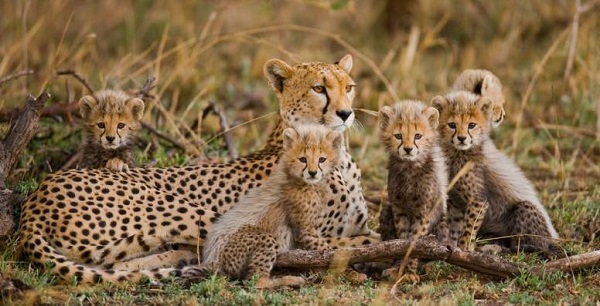
The Cheetah is the fastest land animal on the planet. It is a member of the family Felidae, which includes the tiger, lion, jaguar, leopard, snow leopard, and other big cats.
The Cheetah is a large, slender cat living in sub-Saharan Africa and the eastern and southern African parks. Cheetahs can also be found in small numbers in southern Algeria, northern Niger and Iran.
Cheetahs are found in open and dry grasslands in the Sub-Saharan region of Africa, although they were once widespread throughout Africa and Asia. The majority of Cheetahs today inhabit natural reserves or parks.
Cheetahs in the wild typically live between 10 – 15 years in the wild. Amazingly how some can reach 20 years of age while in captivity.
See some interesting facts about cheetahs below.
1. The Cheetah tail helps them steer at high speed. It may look large and cumbersome, but when on the chase, the tail of the Cheetah plays an important role. It helps to steer the cheetah as it runs, like a rudder on a boat.
2. Cheetahs get tired quickly. It’s fascinating how the fastest animal on land gets tired easily while on a hunt or pursuit. Due to the energy required to run at such speed, cheetahs can only maintain a chase for between 200 – 300m. If a hunt isn’t successful after 1 min, they rest.
3. Fossils have revealed that Cheetahs date way, way back. Carbon dating has estimated the age of some cheetah fossils as being between one and two million years old.
4. Cheetah can’t roar. Unlike big cats like the lion, cheetahs are unable to roar. They are closer to your domestic house cat in that they can purr, both inhaling and exhaling.
5. Female adult cheetahs often live alone. Known to be typically isolated animals, females raise their cubs alone for about a year before they leave. Male cheetahs sometimes live in a small group of brothers from the same litter.
6. The cheetah’s spots act as camouflage. The cheetah can have between 2,000 and 3,000 spots, to help it blend into surroundings when hunting or hiding from predators.
7. There is no end to the cheetah mating season. Cheetahs can mate any time of the year with gestation lasting just three months. A litter can range between 2 and 4 cubs.
8. Cheetahs abandon around 10% of kills to larger predators. To prevent losing their kill to another big and nasty carnivore (lions, hyenas or even vultures), Cheetahs will move their prey to a secluded spot, and eat quickly.
They will also hunt during the day when predators are generally asleep, and only end up abandoning a relatively small number of kills.
9. Cheetah cubs have a very different coat to that of adults. The cubs have a smoky colored, long, wooly coat called a mantle. It runs down their backs and acts as a form of camouflage.
It helps to conceal the cubs and their mothers assist in this by constantly seeking places to ‘hide’ them to protect the cubs from predators until they are old enough to take care of themselves.
10. Cheetahs start families early. The male can reproduce at the age of one, while females can begin rearing families at the age of two. The pairing is mostly random as cheetahs will mate with many different cheetahs during their lifetime.
11. Cubs get moved around a lot. Female cheetahs will move their cubs to different hiding places every few days. Once the cubs reach 5 or 6 weeks of age, they will follow their mothers and even start eating from their kills.
By the time the cubs reach one year of age, they are hunting on their own. At 15 months, they will move away from their mother and either find a mate or sometimes live in a small group.
12. Cheetahs don’t need to drink lots of water. Having adapted for life in an environment where there is little water, cheetahs can go three to four days without a drop of it.
That doesn’t mean that they don’t get any liquids at all. As it turns out, cheetahs can draw water from the animals they hunt, kill and eat.
13. Cheetah cubs have a shockingly high mortality rate. One study in the 90s in the Serengeti found that 95% of cubs died before reaching adulthood.
Many deaths were due to lions, but also other predators and disease.
14. Females end up raising their young alone. Males do not participate in the rearing of their young. Female cheetahs are caring, affectionate and dedicated mothers.
15. Cheetahs abandon hunts due to overheating when running. Two Harvard scientists in 1973 set up an artificial experiment in a laboratory, that concluded that a cheetah would be forced to stop running when their body temperature reached 40.5 degrees Celsius.
16. Cheetahs are capable of turning in mid-air. The Cheetah is the only big cat that is capable of turning in mid-air while sprinting.
Studies concluded cheetahs can use their tails to change body orientation in mid-air, which further aids their incredible agility and hunting prowess.
17. Cheetahs are slowly disappearing from the planet. At the turn of the 20th century, there were well over 100,000 cheetahs. Today the numbers are considerably less with roughly 7,000 in Africa and a few hundred in Iran.
They have been driven out of their historic range by humans, and are now only found in Algeria, Angola, Northern Niger, Namibia, Zimbabwe, Botswana, South Africa, and Mozambique.
The species is already almost extinct in Asia, with fewer than 50 individuals remaining in one isolated pocket of Iran.
18. Cheetahs were considered sacred. Sumerians trained cheetahs for hunting back in 3000 BC. The Indian (then Hindustan) ruler Emperor Akbar had 1,000 trained cheetahs he used for hunting while in power from 1556 to 1605.
Even King Tut’s tomb (1400 BC) contained various cheetah artifacts. It was because of this that historians believed that the cheetah was a sacred animal to ancient Egyptians.
19. Cheetahs don’t simply rely on their speed, they anticipate the escape tactics of different prey when hunting.
A team or researchers found that Cheetahs hunting tactics were specific to characteristics of their prey, and are far more sophisticated than thought.
20. A cheetah’s heart, lungs, and nasal passages are all enlarged to support their high-speed running.
21. A cheetah’s spots are as unique as human fingerprints – no two cheetahs have the same pattern.
22. The black “tear marks” running from their eyes are thought to help reflect the glare of the sun and improve their vision.
23. Unlike other big cats, cheetahs have semi-retractable claws, which help them grip the ground for traction during their sprints.
24. Cheetahs have exceptional eyesight, allowing them to spot prey from great distances.
25. Cheetahs have around 2,000 spots, and each individual has a unique pattern.
26. While they can climb trees, cheetahs are not natural climbers like leopards and are built for speed, not climbing.
27. Cheetahs were historically kept as pets and trained for hunting by royalty and wealthy individuals.
28. Cheetahs are not naturally aggressive and are considered timid animals.
29. Cheetahs are primarily diurnal hunters, meaning they hunt during the day, with peaks during dawn and dusk.
30. Only male cheetahs are social. Males cheetahs have been known to form coalitions of 2-3 so that they can defend as much land as possible.
70% of these coalitions are made up of brothers, but occasionally they include outsiders. Males are generally not territorial towards each other, but can be towards other coalitions or solitary males.



